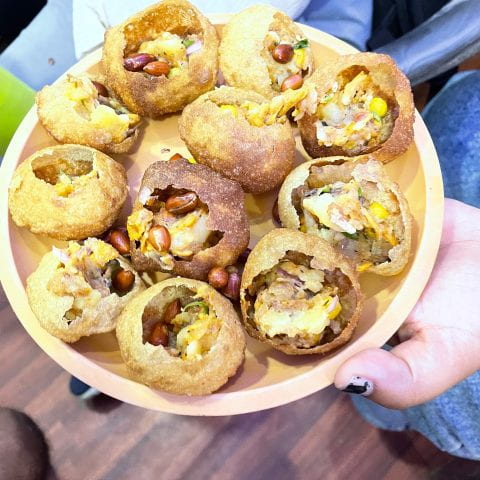Snacking like Locals
Lucy Cheeley
One day, I spent the afternoon in the lab learning about DNA extraction from Dr. Amir, a resident vet at the wildlife hospital. The tutorial took almost three hours before the lab computer broke, bringing an abrupt pause to our work. While the computer was being fixed, the few of us waiting there decided to get milk tea from the shop across the street. We had tea and biscuits over light conversation when suddenly, my colleague Krishna asked me if I’ve ever tried Wai Wai. I have never heard of it, so she jumped up and got a bag from the shelf. She held it up and said, “This is the ultimate Nepali snack.” The three of them were excitedly opening the bag and crushing the instant noodles. Krishna explained that Wai Wai can be eaten cooked, but it’s better raw. They began opening the masala flavoring and oil packets, pouring them in the bag, then shaking it to mix. They passed the bag around the table, so each person had a turn to shake it. Krishna told me that its not necessary or traditional for everyone to shake it, but it’s more fun that way. Then we each took a pinch of the crushed up instant noodles to eat. The flavor was well seasoned, salty, and quite good! Krishna said that it’s even better If mixed with raw onions, tomatoes, chilis, and a squirt of lime.

Wai Wai noodles were invented by Binod Chaudhary, also known as the “Wai Wai Billionaire.” In short, Chaudhary bought the Thai instant noodle company which literally translates to “Fast Fast” in Thai and began manufacturing the noodles in Kathmandu. However, he changed the recipe to better match the preferred taste profile of the Nepali people. The noodles became an instant hit because the new taste of brown noodles was new to Nepali consumers. Nepalis eat around 4 million packets of instant noodles a day, or if you do the math, 3000 packets each minute. Nepal is the second largest consumer of instant noodles in the world, just behind South Korea. Chaudhary has personally stated in several interviews that Wai Wai is a “staple” in the Nepali diet. Sold at a meagre 15 rupees per packet, there’s no question to why it became so popular. It’s also popular because it’s easy to eat, and the only style of noodle you can eat without cooking beforehand. Chaudhary is the first and only Nepali on the Forbes Billionaire list because of his instant noodle success.
The next day we all went to a get another Nepali snack after lab. We took a little motorized car called a tuk-tuk by some people, but here it’s commonly referred to as an auto. Some of us squeezed into the back of the auto while others took a scooter to the “Tik Tok Restaurant” otherwise called “Old is Gold.” I’m not sure what that means, but apparently the shop has a Tik Tok account that became popular, and they use it for marketing.




This place was famous for panipuri, a delicious Nepali street food. Panipuri is a hollow fried flatbread filled (called the puri) filled with chickpeas, potatoes, onion, masala mash, or some combination. Then the puri is filled with a flavored water, usually tamarind or mint, called the pani. The whole ball is eaten in one bite, and the flavor explodes in your mouth. We also had another version called dahipuri, which is similar except for the puri is topped with yogurt, sev (crispy noodles), and a chili sauce. There is no water added to this version, but it is still eaten in one bite. The panipuri had a subtle heat to it, making our mouths feel very tingly, whereas the dahipuri was flavorful, slightly sweet, and mild due to the yogurt. Both were very refreshing in the hot Nepali summer heat.


Our new friends from the lab also made us chaatpate, another common street snack in Nepal and other parts of Asia. Chaatpate is a combination of many snack foods into one big “party mix.” The base is soft, cooked potatoes, puffed rice, Wai Wai, chickpeas, chips (such as masala munch), wasabi peas, peanuts, fresh chili, and a squirt of lime juice. This snack was like a bigger, better, more complex version of the Wai Wai snack we had previously. All the ingredients were put into a big plastic bag and shaken to mix all the ingredients together. The softness of the potato contrasted with the crunchy Wai Wai, and the heat of the chili was complimented by the acidity of the lime juice. Overall, the concept reminded me of the American snack Munchies, with a bunch of different kinds of chips in one bag.


Thanks to Krishna and the other lab techs for introducing us to Nepali snack food!
